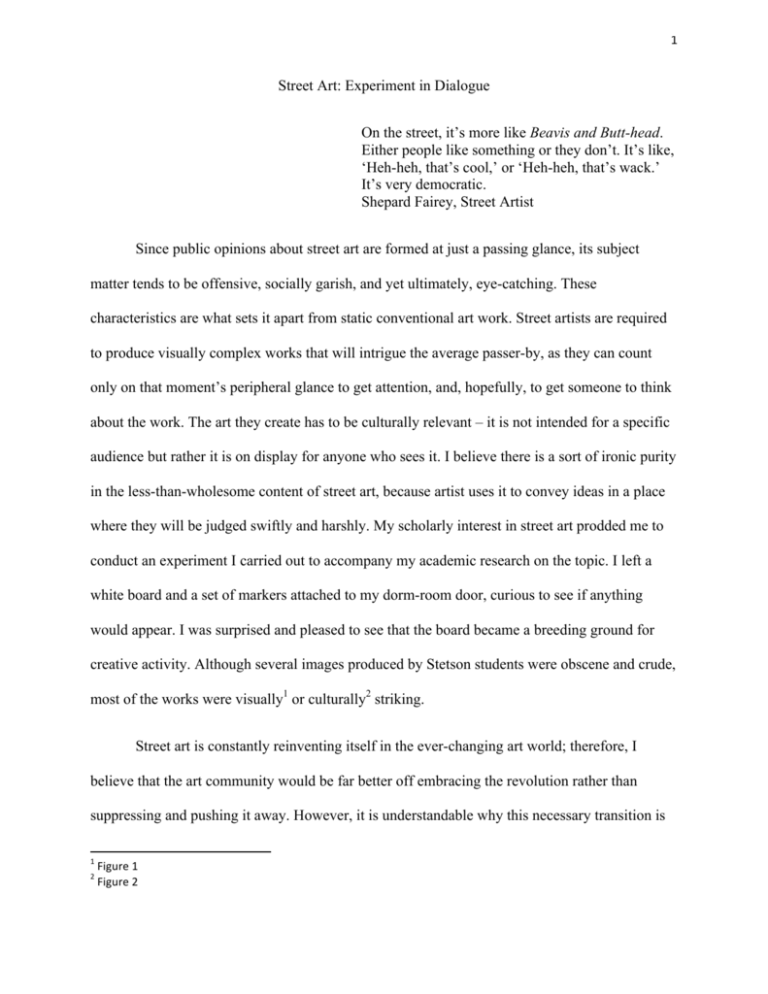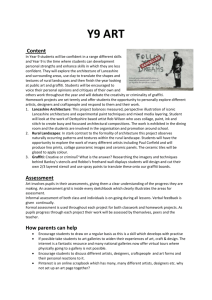Street Art: Experiment in Dialogue
advertisement

! 1! Street Art: Experiment in Dialogue On the street, it’s more like Beavis and Butt-head. Either people like something or they don’t. It’s like, ‘Heh-heh, that’s cool,’ or ‘Heh-heh, that’s wack.’ It’s very democratic. Shepard Fairey, Street Artist Since public opinions about street art are formed at just a passing glance, its subject matter tends to be offensive, socially garish, and yet ultimately, eye-catching. These characteristics are what sets it apart from static conventional art work. Street artists are required to produce visually complex works that will intrigue the average passer-by, as they can count only on that moment’s peripheral glance to get attention, and, hopefully, to get someone to think about the work. The art they create has to be culturally relevant – it is not intended for a specific audience but rather it is on display for anyone who sees it. I believe there is a sort of ironic purity in the less-than-wholesome content of street art, because artist uses it to convey ideas in a place where they will be judged swiftly and harshly. My scholarly interest in street art prodded me to conduct an experiment I carried out to accompany my academic research on the topic. I left a white board and a set of markers attached to my dorm-room door, curious to see if anything would appear. I was surprised and pleased to see that the board became a breeding ground for creative activity. Although several images produced by Stetson students were obscene and crude, most of the works were visually1 or culturally2 striking. Street art is constantly reinventing itself in the ever-changing art world; therefore, I believe that the art community would be far better off embracing the revolution rather than suppressing and pushing it away. However, it is understandable why this necessary transition is !!!!!!!!!!!!!!!!!!!!!!!!!!!!!!!!!!!!!!!!!!!!!!!!!!!!!!!!!!!!! 1 2 !Figure!1! !Figure!2! ! 2! stressful; street art offers a radically different way to display art when the monotone galleries with sterile white walls are the norm. It should be noted that street art isn’t too far off from working its way into the gallery or museum, as it shares many conceptual devices with recognized and accepted art styles. It draws from diverse cultural sources, from the catchy themes of pop art to the dark undertones of graffiti. Street art is produced in public space, usually with the use of stencils or preprinted paper. It is most often infused with a liberal antiauthoritarian message3, and left in public spaces in an effort to bring the artwork to the people; it is thought provoking and unconventional. Street art has absorbed many artistic strategies of the art world, and the art world could learn much from street art. And, really… isn’t that what the growth and creation of art is about? Stylistically, the foundation of street art could be traced to Pop art. There are many qualities that tie these two movements together, for example the use of artistic technique of repetition. Andy Warhol, the most influential American Pop artist, was very fond of the idea of repetition in his works. He would mass-produce images of celebrities making a social statement on how Hollywood churns out celebrities so they can be consumed by the public on a mass scale. However, in doing so, the artist would inevitably break down their image and almost make it lose its purpose, as a word that is said repetitively can lose meaning.4 Doing something ad nauseum can simultaneously change and enhance the original purpose or idea, and this is something street artist Shepard Fairy is quite aware of. Ubiquitous for his widely circulated picture of Andre the Giant captioned with the word OBEY, Fairey has become a prominent figure in the street art world ever since. Much as Warhol used repetition to bring up controversial questions on the !!!!!!!!!!!!!!!!!!!!!!!!!!!!!!!!!!!!!!!!!!!!!!!!!!!!!!!!!!!!! 3 !Figure!5! !Martin,!Gary,!and!Gertrude!Stein.!"A!Rose!Is!a!Rose!Is!a!Rose."!The$Meanings$and$Origins$of$Sayings$and$Phrases.! Web.!10!Nov.!2011.!<http://www.phrases.org.uk/meanings/15900.html>.! 4 ! 3! validity of originality in art, Fairy’s repetitive images, which negated the very possibility of producing fixed meanings, also challenged the public. In an interview with the art critic Steven Heller, Fairey explained that the power of his Obey image was precisely in its ambiguity: “Obey seemed to get under people's skin because they didn't know what to make of it. This ambiguity promoted a debate about the intent of Obey and got a lot of issues out on the table that people would not have discussed if they were able to classify and immediately ignore it.”5 The use of repetition made Fairey’s artwork a perfect vehicle for discussion because it promoted a conversation about art among common people, rather than cultural elite. The general public was prodded to question this dark looming image and the reasons for its circulation in public spaces. Fairey isn’t the only Street artist to use repetition as an artistic device either: father of stencil art6, Blek Le Rat, used the same rat stencil all over town to give the appearance of being overtaken by the shadow of rats. The second affinity between the Pop art and street art is the use of culturally relevant images. Pop art focused on showing everyday items such as product packaging7, comic book images8, or even household appliances as artwork9. This is very similar to the artistic practice of street artists who use images that are ingrained in our culture in order to evoke emotional response. British artist Banksy became notorious for portraying policemen. For an average !!!!!!!!!!!!!!!!!!!!!!!!!!!!!!!!!!!!!!!!!!!!!!!!!!!!!!!!!!!!! 5 !Heller,!Steven.!"AIGA!|!Interview!with!Shepard!Fairey:!Still!Obeying!After!All!These!Years."AIGA$|$the$Professional$ Association$for$Design.!AIGA,!4!June!2004.!Web.!01!Nov.!2011.!<http://www.aiga.org/interviewTwithTshepardT faireyTstillTobeyingTafterTallTtheseTyear/>.! 6 !"The!Father!of!Stencil!Art...!Blek!Le!Rat."!DesignTaxi.!18!Oct.!2006.!Web.!<http://designtaxi.com/news/5211/TheT FatherTofTStencilTArtTBlekTLeTRat/>.! 7 !"Andy!Warhol's!Campbell’s!Soup!Can!(Tomato)!|!PostTWar!and!Contemporary!Art!|!Special!Feature!|! Christie's."!Christie's:$Fine$Art$Auctions$and$Private$Sales$for$Contemporary,$Modern,$Old$Master$Paintings,$Jewelry,$ Watches,$Wine,$Furniture$&$More.!21!Oct.!2010.!Web.!10!Nov.!2011.!<http://www.christies.com/features/2010T octoberTandyTwarholTcampbellsTsoupTcanTtomatoT1022T1.aspx>.! 8 !"Tate!Collection!|!Whaam!!by!Roy!Lichtenstein."!Tate:$British$and$International$Modern$and$Contemporary$Art.! Web.!10!Nov.!2011.!<http://www.tate.org.uk/servlet/ViewWork?workid=8782>.! 9 !"Tate!Online:!ARTIST!ROOMS!|!JEFF!KOONS."!Tate:$British$and$International$Modern$and$Contemporary$Art.!Web.! 10!Nov.!2011.!<http://www.tate.org.uk/collection/artistrooms/artist.do?id=2368>.! ! 4! person, the image of policeman is often associated with an idea of protection of the public peace. However, Banksy made these policemen to do something quite visually and socially obscene: they were depicted kissing passionately.10 These rampant enforcers of justice were recast in a very humorous and entertaining light. The image made a mockery of strong valiant protectors: these enforcers had lost all their power, which paradoxically made them human. Through the use of this emotionally charged imagery, street artists were able to convey strong social statements without being didactic and boring, which certainly separates their artistic project from propaganda. Final, and most interesting, similarity that Street and Pop art share is the production method. Pop artists often mass-produced their works. For example, Warhol had a very little physical input in the actual creation of his works, which were done by his assistants. When asked about the involvement of his assistants in the production process, he unapologetically stated: “No one would know whether my picture was mine or somebody else’s.”11 Street art’s production process is similar to Warhol’s because the artists use stencils or preprinted images. But for street artists this particular production method, which increases the speed of execution of artworks, is also an issue of necessity, because their works are done on public property, which makes them illegal. Thus, the conceptual meaning of the images is valued more than the display of technical expertise. However, this simplification of production does not result in mediocrity, leading instead to creative diversity. If the same tools are available to everyone, then artists will find the competitive drive to stand out, to be that one person who appears to have higher skills and talent !!!!!!!!!!!!!!!!!!!!!!!!!!!!!!!!!!!!!!!!!!!!!!!!!!!!!!!!!!!!! 10 !"Banksy!Kissing!Policemen!Stencil,!Brighton!|!Flickr!T!Photo!Sharing!"!Welcome$to$Flickr$K$Photo$Sharing.!Web.!01! Nov.!2011.!<http://www.flickr.com/photos/simonbooth/16129664/>.! 11 !Crone,!Rainer.!"What!Andy!Warhol!Really!Did!by!Rainer!Crone!|!The!New!York!Review!of!Books."!Home$|$The$ New$York$Review$of$Books.!Web.!01!Nov.!2011.!<http://www.nybooks.com/articles/archives/2010/feb/25/whatT andyTwarholTreallyTdid/>.! ! 5! than the rest. Or at least to appear to know more than everyone else, as was the method in Warhol’s case. Apart from Pop art, graffiti is another major source of influence for Street art. The most common type of graffiti is called “tagging”. Tagging is characterized by artists writing out their names in a very stylized manner: large brightly colored bubble letters placed on a public walls, trucks, or subway trains. While working under the constant pressure that they might get caught at any moment, street artists assert their reputation in a particular urban area through tagging. As graffiti artist competed to outdo each other, they have invented the concept of “bombing.” Artist would work to “bomb” the hardest to reach or most publicly accessible area with the most glorified version of their tag. This is where a thin line must be drawn between graffiti and street art. Whereas graffiti artist use their tags to claim an area, street artists work to breathe a new life into that area with political or social commentary that is left for the audience to contemplate. As Blek Le Rat asserts: “My stencils are a present, introducing people to the world of art, loaded with a political message. This movement is the democratisation of art: if the people cannot come to the gallery, we bring the gallery to the people!”12 The government officials, however, are never too happy with having to spend public funds to remove tags from public property and as such they work to convict graffiti artists. A notorious tagger working under the name “Tox” was recently convicted for his wide spread tagging of his name.13 The court system tried to make a distinction between graffiti and street !!!!!!!!!!!!!!!!!!!!!!!!!!!!!!!!!!!!!!!!!!!!!!!!!!!!!!!!!!!!! 12 !"Blek!Le!Rat:!This!Is!Not!a!Banksy."!The$Independent$|$News$|$UK$and$Worldwide$News$|$Newspaper.!Web.!22! Sept.!2011.!<http://www.independent.co.uk/artsTentertainment/art/features/blekTleTratTthisTisTnotTaTbanksyT 811130.html>.! 13 !Davies,!Caroline.!"'Tox'!Graffiti!Artist!Convicted!of!Criminal!Damage!|!Art!and!Design!|!The!Guardian."!Latest$ News,$Sport$and$Comment$from$the$Guardian$|$The$Guardian.!7!June!2011.!Web.!02!Nov.!2011.! <http://www.guardian.co.uk/artanddesign/2011/jun/07/toxTgraffitiTartistTcriminalTdamage>.! ! 6! artists, insisting that Tox’s tags lacked artistic merit because of its redundancy (“his statement is Tox, Tox, Tox, Tox, over and over again”) and poor artistic skill (his work was "incredibly basic" and lacking "skill, flair or unique style".)14 However, there is one form of graffiti that stands out as it is considered to be the lowest of the low. I’m referring to the messages sprawled in bathroom stalls, a form of graffiti that nearly everyone has experienced at one point or another. However, I believe that this particular type of graffiti should be praised as it is done neither for critical acclaim nor personal gain. Could an argument be made that bathroom graffiti is, indeed, the purest form of art? It establishes a fleeting moment of contact between the writer/artist and the spectator.15 The people who produce these images work anonymously, with no intentions for monetary or reputational gain, just out of desire to leave something for another person to see and respond to. Isn’t this the very definition of art for art’s sake? In order to test my theories, I have conducted an experiment to accompany my scholarly research for this paper. I have decided to leave a blank white board in a public space: my dorm hall populated by Stetson freshmen. Many of the aspects that were crucial for street art (method of production and content of images) could now be examined empirically. The public judgments on what was drawn on the board were made instantly as any passing person had the ability to erase any previous work. I tracked the board’s evolution and I came to conclusion that it went through three phases, which I have titled Curiosity, Acquainting, and Resolution. !!!!!!!!!!!!!!!!!!!!!!!!!!!!!!!!!!!!!!!!!!!!!!!!!!!!!!!!!!!!! 14 !Davies,!Caroline.!"'Tox'!Graffiti!Artist!Convicted!of!Criminal!Damage!|!Art!and!Design!|!The!Guardian."!Latest$ News,$Sport$and$Comment$from$the$Guardian$|$The$Guardian.!7!June!2011.!Web.!02!Nov.!2011.! <http://www.guardian.co.uk/artanddesign/2011/jun/07/toxTgraffitiTartistTcriminalTdamage>.! 15 !Fig.!3! ! 7! The first stage was Curiosity. Something new had appeared in this public space and people wanted to put it to use, for no reason other than its availability to them. The first things to appear were short welcome messages, something that is a kind and expected social norm, testing the proverbial water in a sense. People used this board as a way to reach out to others in this new environment they found themselves in. No one however wanted to take the leap and draw anything with too much purpose as the board was still something new to them, and anything they created would be on public display. But soon, multiple variations of one ubiquitous image, that of male genitals, started appearing on the board.16 The best explanations of why over 20 penises were depicted over the course of my experiment is that these images are easy to draw and catch attention. They are not difficult to execute, their production does not require any technical skill, but their crude sexual meaning was a way to ensure reaction. However, a month into the experiment, the images on the board took an unexpected and dramatic turn towards the acquainting stage. Much to my surprise, rather well done17 and thought out18 drawings began to appear. Now the artists wanted to show off their talent rather than merely scandalize their audience. Time, effort, and skill went into production of these works, temporal in nature, because they would last no longer then a day or two. This phase is characterized by a mix of new strong artists emerging and testing their new workspace. Each of these artists often worked to establish a theme or style that would make their work recognizable, as is seen with Fig. 6 and Fig. 7. Even though these artists did not have a name or signature their works were easily identifiable. But why do these anonymous artists feel compelled to create something in this space, which isn’t permanent of definite at all? It isn’t done for personal !!!!!!!!!!!!!!!!!!!!!!!!!!!!!!!!!!!!!!!!!!!!!!!!!!!!!!!!!!!!! 16 !Figure!5! !Figure!6! 18 !Figure!7! 17 ! 8! acclaim as no signature is left. I believe they were making these images for the same reason wanted street artist Blek produced his works: to leave a little present for the passerby to enjoy. It is a selfless action done to provide entertainment for the general public. And finally, in its third stage of resolution, the board became much more somber and creative. Artists would come and go, leaving artworks on the board or commenting on other works. Good art continued to appear such as the Knights of Suit work19 that embodied the high standard of quality that the board came to be known for. Artists continued to work to impress and now even in competition with each other. The board ultimately became an open social forum for people to express or inspire ideas freely. Often people would write small friendly messages to each other.20 This is way I had hoped the board would develop, with it now being a wonderful outlet for creative expression and commentary. And, ultimately, that is what street art is and why it is meaningful, and why it should be embraced, for art is about appearance and message. Street art not only captures both, but refuses to limit itself. !!!!!!!!!!!!!!!!!!!!!!!!!!!!!!!!!!!!!!!!!!!!!!!!!!!!!!!!!!!!! 19 !Figure!8! !Figure!9! 20 Figure 1: Blue-Eyes White Board Dragon (October 03, 2011) ! ! Figure 2: Art-Ception (October 10, 2011) ! ! Figure 3: Shower Party (October 9, 2011) ! ! ! ! Figure 4: Look Down (October 11, 2011) ! ! ! ! ! ! ! ! ! Figure 5: Banksy ! Figure 6: Grapes (October 4, 2011) One of the first drawings to appear, notice the streak through the face, just a reminder of how fragile and fleeting these drawings are. Figure 7: Green Bean Girl (October 5, 2011) Another early drawing presumably from the same artist as it maintains the same theme. Figure 8: Three of a Kind (November 01, 2011) Wonderful piece left during final phase. The “3 line system” referred to is the method of starting a drawing around three parallel lines and going from there as is seen in the spears. Figure 9: Sloths (October 09, 2011) Example of board being used to post messages during tail end of experiment. For the record that sketch is hilarious.






